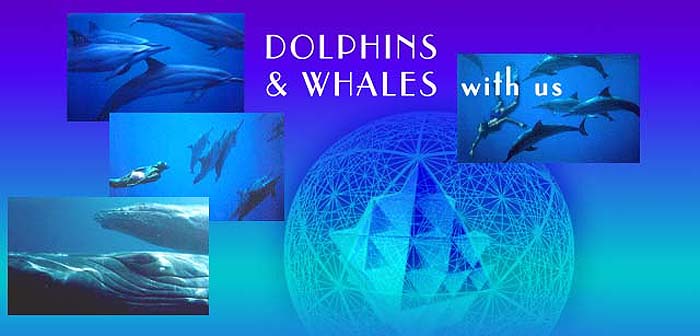

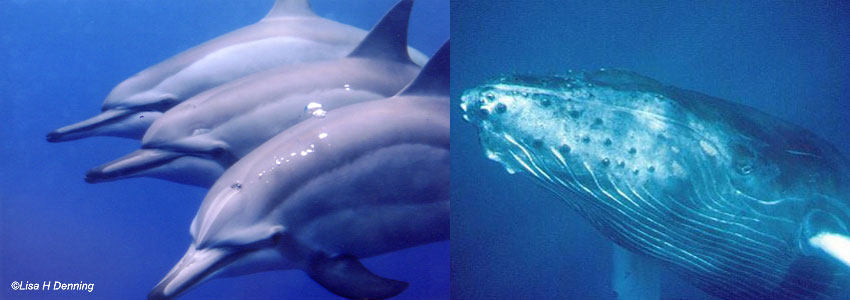
|
DOLPHIN INFORMATIONFor the past twenty five years Joan has been swimming with wild Spinner dolphins in Hawaii. She has witnessed births and come to know the babies. Many of the dolphins we will meet have been Joan's friends for a long time; they have names based on identifying marks and are happy to swim among people. This behavior of the dolphins has grown out of years of developing trust together which continues to be reinforced by the gentle interactions we have with the pods every day. This is a friendship we value and choose to maintain.
The way we interact with dolphins is to become like a dolphin when entering the water. This means mimicking their behavior. ~~~If for example, they are joyful and playful, we laugh, dive and somersault with them. If they are quiet, we are meditative and slow with them. Then we do not dive right above them or startle them in any way. We let them approach us and softly swim among us. We swim in the same direction, never cutting directly toward them, but becoming a member of the pod and turning and diving slowly and evenly whenever they do. Very deep communications occur. The dolphins do not want you to touch them. If you reach out they swim away. To keep them close to you, swim with your ams at your sides and propel yourself along by kicking your fins only. Mimicking their sounds is recommended. They appreciate your attemps to talk to them in their language.
When we leave the coastline by boat to meet the dolphins in the deep blue, we acknowledge the dolphins as the masters of the seas and we follow their lead. We enter the water when they have brought us to a safe bay or place in the ocean. When they are ready for us to swim among them, they mill around the boat, waiting for us.
IT IS GREAT FUN!
____________
____________
VARIETIES OF DOLPHINS
photo by Lisa Denning, Kona, HI

LISA DENNING'S IMAGE OF BOTTLENOSE
DOLPHINS
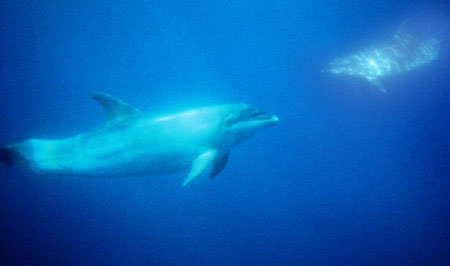
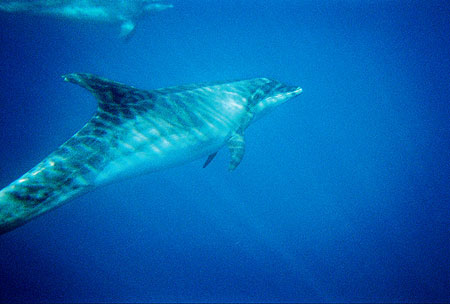
BOTTLENOSE
DIVING BIRDS WITH DOLPHINS SEA OF FINS
SPOTTED DOLPHINS FROM THE BOAT
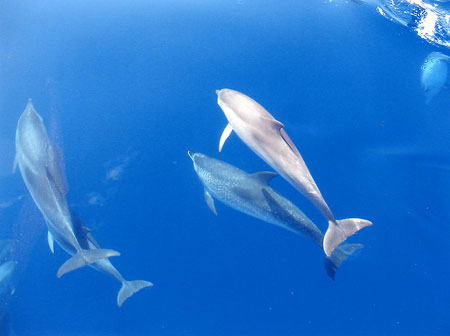
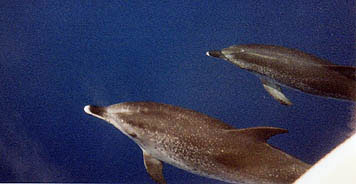
RISSO DOLPHINS 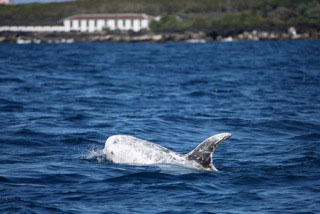

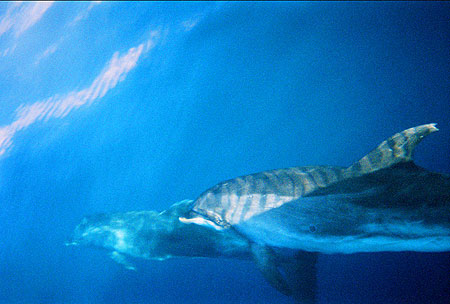

OUR FRIENDS THE SPINNER DOLHINS
BUBBLES
& OTHER SEALIFE
Anita's Pictures of our dolphins playing
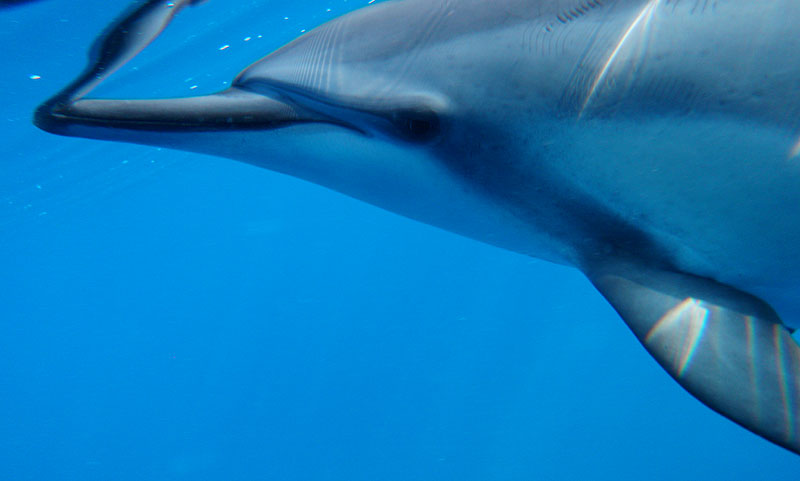
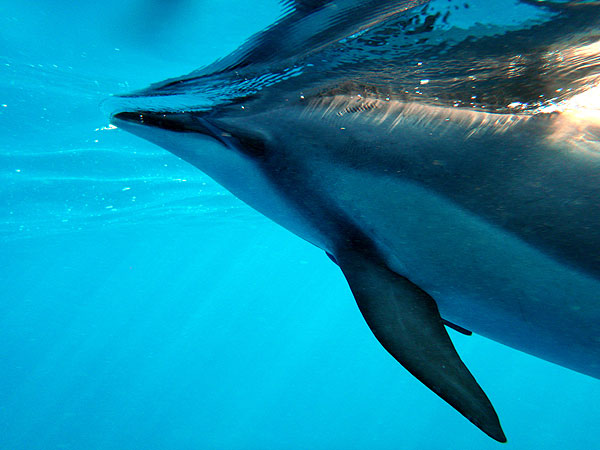
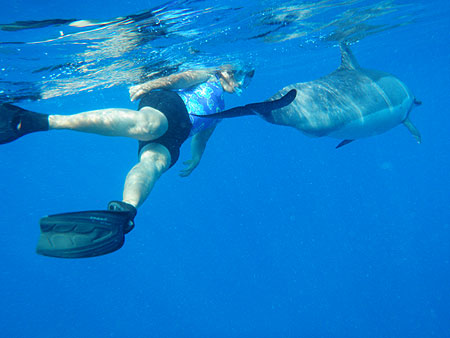
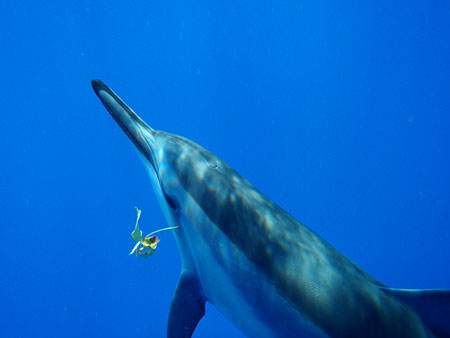
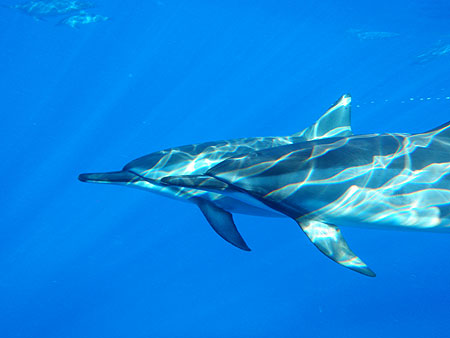
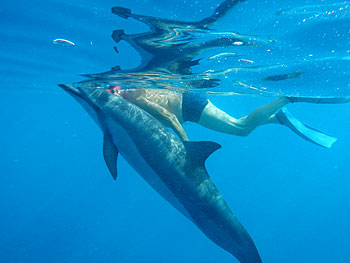
Images are © ANITA ROSSING (used by permission)
![Dolphin Connection, All Rights Reserved [CLICK TO ALUBM PAGE]](Resource/GALflwr.jpg)
PARTICIPATORY RESEARCH
My way of being with the dolphins and whales is as a researcher who lives among them to learn about their culture. Overall I choose not to label the work I am doing with the dolphins, because sometimes labeling an activity immediately limits our understanding of that process. But over time, the name "Participatory Research" has come to effectively express the nature of my interactive cetacean communication research. This work is quite different from traditional types of observational and experimental research conducted on dolphins. Participatory Research requires that the scientist participate with the dolphins and whales in the educational process. It does not separate the human from the cetacean as the observer and the observed. As I collect information, there is no division between researcher and subject, teacher and student, their physical body and mine, their energy field and mine. We are connected by our close proximity to each other, by our awareness of each other, and by the frequencies that move life through our bodies. Our information merges to co-create a unity of mind, feelings and wave patterns. We influence each other, we affect each other, and we both benefit from this energy exchange.
When a dolphin or whale swims towards me, I move into a parallel position alongside, and join her as any other cetacean would. I open myself empathetically to the feelings and thoughts I receive in her presence. But I do not just passively register these, I also respond back to her, understanding that my response to her is as significant as her original communication to me. The research is about the interaction we share with each other. To accomplish this, it is important that I remain open to the unexpected, treat each exchange as unique, and resist any inclination to apply previously made interpretations to the interactions. The dolphins support this by continually changing their behavior. The minute I think, "A ha, I see a pattern in their interactions with me; I know what’s coming next," they behave in a way that is different from anything they have done before. This experience encourages me to accept reality as constant change and to live spontaneously in the present without depending on unnecessary beliefs from the past.
Participatory Research requires perseverance and stamina. It means swimming with dolphins on a daily basis and mimicking their behavior and sounds. It is similar to the way a baby learns to be a part of her family and society — she is silent at first, strengthening her eyes and ears, observing and listening. Gradually she imitates sounds and behaviors from her environment as she learns about life in her family. I am doing the same with my dolphin family. I am learning about them, learning about their songs and about living in the ocean. It is a different way of life, a different dimension, which includes ways of communicating which are at once more complex and more simple than those we use on land.
FROM THE DOLPHIN JOURNAL . . . . . .
The dolphins arrive at 6:44 a.m. today. The sun is just rising over the hill and it is a welcome sight after three days of rain. I swim a half mile to the cliff, treading water, waiting, knowing this is Pod C behavior. They usually sonar me, have a discussion and then swim over! Sure enough, I see them now, playing and diving as they come. No hurry. After about fifteen minutes there are eleven dolphins beneath me. I hear soft whistles being exchanged. I wonder if these are the only ones here today as I scan their bodies for identifying marks. They cruise on by.
All at once three dolphins surface at my side, nearly colliding with me. I am momentarily surprised and then filled with great joy as I recognize my old friend, Exx from Pod A. He is swimming apart from Pod C with Fancy and Ribbon. Fancy and Exx sandwich me between them, and Ribbon swims to the right of Exx. I have to lower my body in the water as we swim, because they are trying to swim over me! They are getting as close as they possibly can. . . . staying with me on the surface, occasionally diving slowly. If I don’t dive with them, they immediately return to my side. When I do follow them in a dive, they watch me with interest while staying in front and leading me down, turning their heads slightly so their eyes remain in contact with mine. They do not spin and circle me the way Bentley and Two Wave do. These three dive sedately together, swimming deeper than I can go.
I return to the surface and they remain cruising along the bottom for a few minutes before floating slowly up, positioning themselves alongside me again. As usual, the dolphins seem very content to have me in their midst as long as I am gentle, graceful, and swimming synchronistically with them. Always aware of this, I match their pace and mood. We swim rhythmically together for two hours, enjoying the benefit of the natural water flowfield we are creating. Occasionally other people come along, but the dolphins guide me away, and we continue our interaction uninterrupted.
Ten dolphins are now below us. I notice a large area of churning water in their midst. Looking more closely, I see a great circle of tightly packed bubbles rising amid a sea of tiny free-floating bubbles, covering an area five feet around. A large eighteen-inch bubble grows out of the profusion of tiny bubbles
As the cluster rises, the large bubble expands and suddenly bursts, leaving a clear passageway of undisturbed water from the surface to the sand below, surrounded by a frenzy of tiny bubbles. I react immediately, diving precisely into this amazing underwater column, surrounded by a foamy bubble-storm. Remaining in place upside down, all I can see is glittering lights sparkling in the underwater sunlight. Dreamily, the six-foot column of bubbles ascends around me. Slowly I swim to the bottom of it and then turn to go up for air while the bubbles continue to drift and pop at the surface. It reminds me of a transportation beam from Star Trek. Beam me up, dolphins!
Please have a look at my new page: PEOPLE HELPING DOLPHINS